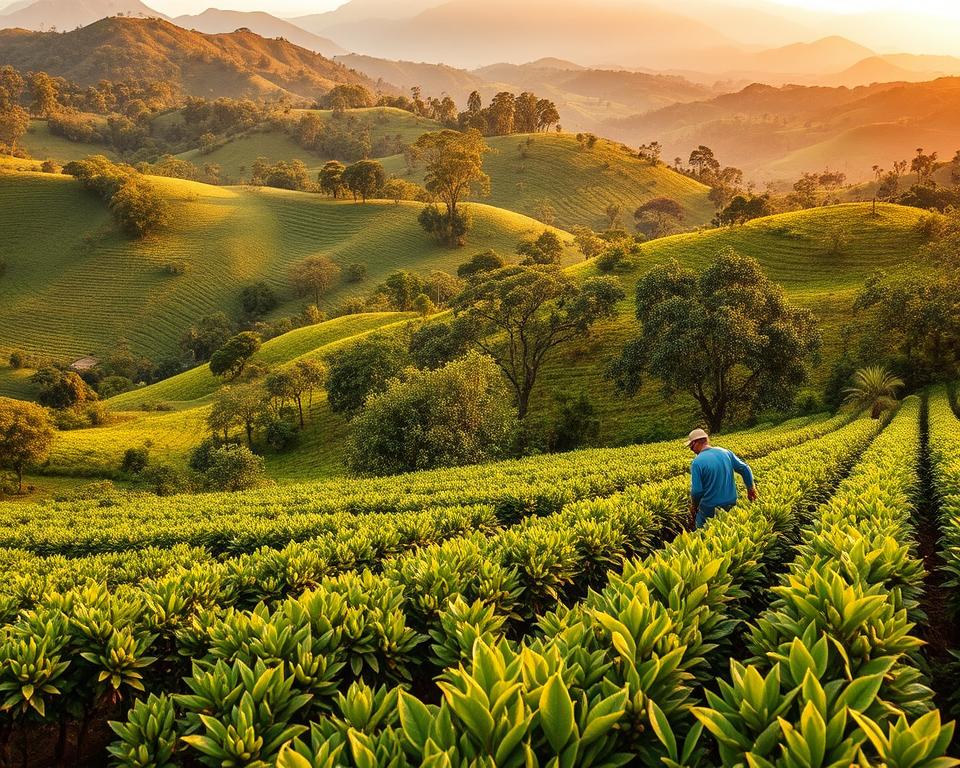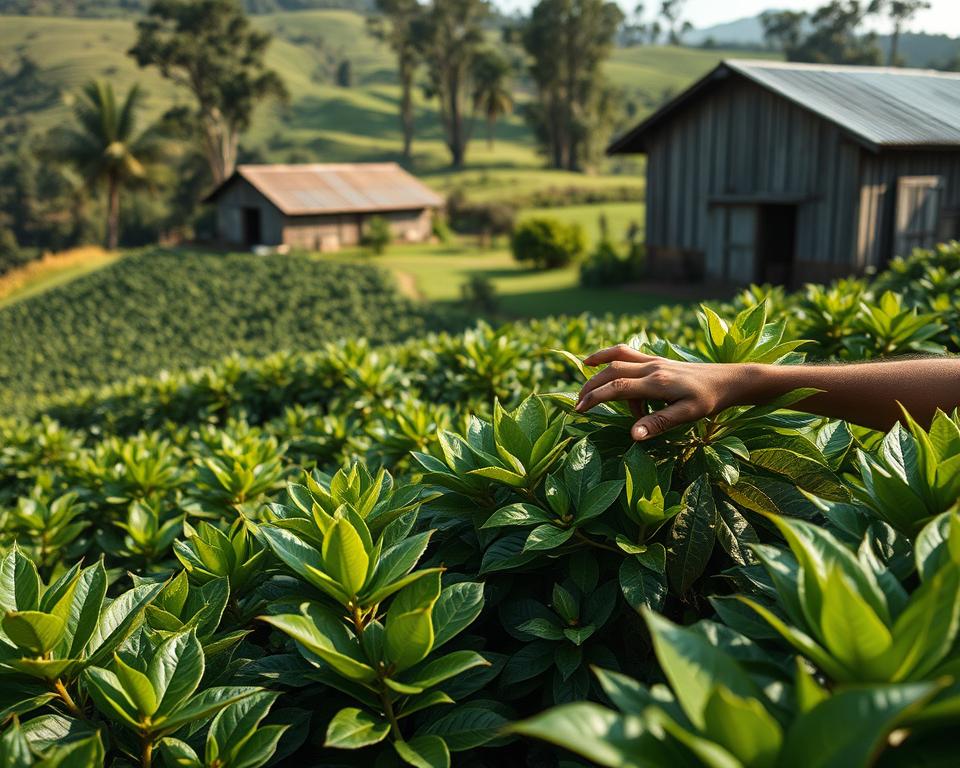Coffee is a global giant, with 12.5 million farms worldwide. Yet, traditional farming methods often damage ecosystems and threaten farmers’ livelihoods. Sustainability is not just a choice—it’s essential for the coffee industry’s future. Small-scale farmers, who adopt eco-friendly practices like shade-grown systems, protect biodiversity and cut down on synthetic fertilizers. These methods not only preserve nature but also increase yields by up to 25%, showing that sustainability and profitability can coexist.
Traditional farming is a significant source of greenhouse gases, with one kilogram of coffee beans emitting 15 kg of CO₂. Eco-friendly practices, such as agroforestry, counteract this by sequestering 1.1 billion tons of CO₂ each year. Small growers in Latin America and Africa, like Rwanda’s Kopakama Cooperative, are pioneering with innovations like bio-digesters to reduce water waste. Their work demonstrates how eco-friendly practices can safeguard the planet and support farmers’ incomes.
In Europe alone, a third of global coffee is consumed, driving demand for responsibly grown beans. By adopting organic farming, which enhances soil fertility by 20%, farmers can command 30% higher prices. This transition benefits the Earth and provides a vital lifeline for millions dependent on the $100 billion coffee economy.
Key Takeaways
- Shade-grown farms boost biodiversity and cut chemical use.
- Agroforestry improves soil fertility by 30% and captures 1.1 billion tons of CO₂ yearly.
- Organic coffee markets grow 20% annually, with premium prices up to 30% higher than conventional.
- Small growers reduce water waste by 50% through smart irrigation and rainwater harvesting.
- Global coffee faces climate threats like leaf rust, making sustainable practices urgent.
Understanding Sustainability in Coffee Production
Every morning, millions of Americans start their day with coffee. But behind every cup lies a complex journey shaped by farming practices that impact people and the planet. Sustainability in coffee ensures this beloved drink supports sustainable development without harming ecosystems or farmer livelihoods.
Sustainability balances three pillars: environmental health, economic fairness, and social equity. For coffee, this means:
- Protecting forests and water sources through environmental conservation
- Ensuring farmers earn stable incomes
- Empowering communities with education and healthcare
What is Sustainability?
Sustainability in agriculture means meeting today’s needs without compromising future generations. Unlike conventional farming, which uses harmful pesticides and monoculture crops, sustainable methods prioritize:
| Conventional Farming | Sustainable Practices |
|---|---|
| Heavy pesticide use | Organic pest control |
| Single crop systems | Agroforestry with shade trees |
| Water-intensive irrigation | Rainwater harvesting systems |
Importance of Sustainability in Agriculture
With global coffee demand rising, unsustainable practices threaten both ecosystems and farmer livelihoods. Deforestation for plantations destroys habitats and accelerates climate change. Sustainable practices like shade-grown coffee retain biodiversity while reducing soil erosion.
“Sustainable practices are not optional—they’re essential for long-term survival.” — World Coffee Research
Companies like Starbucks and Nespresso are leading change, but small growers need support to adopt methods like composting and crop diversification. Every step toward sustainability helps protect the livelihoods of 125 million people worldwide and preserves the land that grows tomorrow’s coffee.
The Environmental Impact of Coffee Farming
Coffee’s global demand strains ecosystems. In Australia, 50 million kilograms of coffee are consumed yearly. Each cup contributes to environmental costs like deforestation and water depletion. Environmental conservation efforts are urgent as coffee’s climate change action potential grows critical.
Deforestation and Biodiversity Loss
Traditional farming often clears forests for sun-grown crops. This practice destroys habitats, pushing species toward extinction. Studies show that 15 kg of CO₂-equivalent is emitted for each kilogram of beans, accelerating climate change.
“Shade-grown coffee preserves ecosystems akin to natural forests.” – Smithsonian Migratory Bird Center
- Each cup of coffee destroyses 1 square inch of rainforest daily.
- Over 200,000 acres of land are cleared globally for agriculture daily, with coffee a major driver.
Water Usage in Coffee Cultivation
Processing 1 kg of beans requires up to 140 liters of water. Wet-milling methods discharge contaminated water, harming aquatic life. Contaminants from pesticides and coffee pulp (57% of cherries) pollute rivers.
| Issue | Conventional Farming | Sustainable Practices |
|---|---|---|
| Deforestation | High | Low (shade-grown) |
| Water Pollution | Severe | Reduced with recycling |
| Carbon Footprint | 15kg CO₂/kg beans | Lower with organic methods |
Small farms can adopt climate change action measures like agroforestry to protect soil and water. These steps align with environmental conservation goals, ensuring future viability for 25 million farmers worldwide.
Eco-Friendly Farming Techniques
“Reduced soil tillage could equal the same reduced carbon emissions as taking 12.4 million cars off the road.” – CropLife International
Small-scale coffee growers can adopt methods that protect ecosystems while boosting profitability. Three proven strategies—organic farming, agroforestry, and pest management—form the backbone of eco-friendly practices that align with green living goals.
Organic Farming Practices
Organic farming skips synthetic chemicals, relying on compost, crop rotation, and cover crops. This improves soil health and water quality while reducing long-term costs. Farmers earn premium prices for certified organic beans, which now command a 30% price increase on global markets. Conservation tillage, which cuts erosion and retains moisture, is a core technique in organic systems.
Agroforestry: A Sustainable Approach
Integrating coffee plants with shade trees like banana or avocado. Trees stabilize soil, attract pollinators, and store carbon. A 2023 study found agroforestry systems sequester 2-3 tons of CO2 per hectare yearly. Farms in Costa Rica now mix cocoa with coffee plants, boosting biodiversity and income from multiple crops.
Integrated Pest Management
IPM uses natural predators, pheromone traps, and crop diversity to control pests. This reduces chemical use by 70% compared to conventional farms. For example, Guatemalan growers release ladybugs to eat aphids, avoiding pesticides. Training programs from organizations like World Coffee Research teach farmers these methods at no cost.
These techniques create resilient farms while meeting growing consumer demand for ethically produced coffee. By adopting these eco-friendly practices, growers join a global movement toward green living without sacrificing yields.
The Role of Small Growers in Sustainable Coffee
Small coffee farmers are the backbone of the global industry, producing 60% of the world’s beans. Their traditional practices often align with sustainability goals, making them vital to reshaping the industry. These growers protect forests, preserve biodiversity, and maintain livelihoods for millions.

Why Small Growers Matter
| Factor | Smallholder Farms | Large Plantations |
|---|---|---|
| Deforestation Impact | Low | High |
| Biodiversity | High (pollinators, shade trees) | Low |
| Chemical Use | Minimal | Higher |
| Carbon Footprint | Lower | Higher |
In Colombia, Nicaragua, and Honduras, small farms employ shaded agroforestry systems. These methods reduce water waste and boost carbon sequestration. Fairtrade International has certified 838,116 farmers worldwide, proving their role in ethical sourcing. Large farms, by contrast, contribute more to deforestation and rely on synthetic inputs.
Empowerment Through Sustainable Practices
“Sustainable practices turn small farms into engines of resilience.” – Fairtrade International
- Higher income via premium prices for ethically sourced beans
- Climate resilience through diversified crops (maize, beans, fruit trees)
- Lower production costs by reducing chemical dependency
By adopting agroforestry, smallholders protect ecosystems while improving yields. This dual benefit strengthens communities and secures the sustainability of coffee supply chains. Supporting these farmers isn’t just ethical—it’s essential for the $100 billion industry’s future.
Certifications and Standards
Certifications empower coffee growers to prove their commitment to sustainable development. These programs connect ethical practices with market recognition, helping small farms thrive in a competitive industry. From climate-smart farming to fair wages, certifications like Fair Trade and Rainforest Alliance set clear benchmarks for verified eco-friendly practices.
Fair Trade Certification
Over 838,000 smallholder farmers in 32 countries rely on Fair Trade certification to access premium prices while meeting strict environmental safeguards. Farms must prevent deforestation, conduct risk assessments, and uphold labor rights to qualify. This ensures coffee is grown without harming forests or workers, aligning with global ethical sourcing goals.
Rainforest Alliance Seal
Coffee carrying the Rainforest Alliance seal must meet rigorous criteria: protecting wildlife habitats, reducing pesticide use, and improving farmer livelihoods. Their climate-smart agriculture methods help farms adapt to climate change while maintaining soil health. This certification directly supports sustainable development by linking production to ecological preservation.
The Importance of Transparency
Consumers increasingly demand proof of sustainability—73% of millennials pay more for certified goods. Blockchain and digital tracking tools now let buyers trace beans from farm to cup, ensuring claims about ethical sourcing are accurate. Transparent supply chains build trust and attract socially conscious buyers.
| Certification | Key Focus | Impact |
|---|---|---|
| Fair Trade | Living wages + environmental safeguards | Supports 838k+ smallholder farmers |
| Rainforest Alliance | Biodiversity protection | Reduces pesticide use by 40% in certified farms |
| Transparency Tools | Blockchain tracking | Ensures 100% traceability for ethical sourcing |
Building a Sustainable Supply Chain
Creating a sustainable supply chain begins with collaboration. Small coffee growers flourish when businesses team up with local communities. Together, they tackle shared goals. This integration of sustainability at every stage—seed to cup—fosters strong partnerships. It ensures the use of renewable energy and ethical labor practices.

Collaborating with Local Communities
- Education programs teach farmers eco-friendly methods.
- Health clinics and infrastructure projects improve quality of life.
- Cooperatives give growers a stronger voice in pricing and practices.
Sourcing Responsibly: From Seed to Cup
Every production stage offers a chance for improvement. Coffee processors can:
- Use solar or wind power in mills and warehouses.
- Track shipments using low-emission transport.
- Ensure roasters invest in renewable energy equipment.
Transparent contracts with fair pricing empower farmers to invest in sustainable practices. Shade-grown coffee, for example, preserves forests and biodiversity. Brands like Starbucks and Fair Trade USA have proven that sustainability enhances brand loyalty and profits.
Consumer Awareness and Sustainability
As more Americans embrace green living, their coffee choices are driving a shift toward sustainable practices. Over 78% of U.S. consumers value a sustainable lifestyle, leading to eco-conscious decisions in the industry. European trends show similar momentum, but the U.S. market’s $14 trillion spending power amplifies this demand. An image of eco-friendly coffee packaging highlights this shift:
The Rise of Eco-Conscious Consumers
Over 60% of U.S. shoppers are willing to pay premiums for sustainable products, according to McKinsey. This trend fuels growth: products with ESG claims outperform non-ESG items by 1.7 percentage points annually. The results are clear—farmers’s eco-friendly practices gain market traction as buyers prioritize climate change action. For instance, ESG-certified coffee brands see 28% growth compared to 20% for conventional brands.
Educating Consumers on Sustainable Choices
Transparent labeling and storytelling are key to informed decisions. Consider these consumer priorities:
- 40% check production methods for environmental impact
- 38% seek sustainable packaging
- 34% demand positive ecological outcomes like water conservation
Education bridges the gap between values and action. Brands like Patagonia or Seventh Generation show how clear messaging boosts trust. Social media amplifies this: 67% discover eco-brands online, while 83% demand data privacy—a balance of transparency and security.
Every purchase becomes a vote for change. When buyers seek Fair Trade or Rainforest Alliance labels, they directly support small growers adopting eco-methods. Together, these choices turn green living into a powerful force for climate change action.
Innovations in Sustainable Coffee Production
Coffee farming is now embracing advanced solutions to balance growth with environmental care. The global coffee market is expanding at a 5.2% CAGR until 2030. Eco-friendly practices are essential for sustainable growth.
Technology is revolutionizing smallholder farms. The Kopakama Cooperative in Rwanda employs bio-digesters to convert wastewater into energy and fertilizer. This reduces water use by up to 40%. Solar-powered processing and IoT sensors for soil moisture are also gaining traction. These innovations help smallholder farmers, who make up 60% of global producers, use resources more efficiently:
- Bio-digesters turning waste into energy
- Solar-powered drying systems
- Smart irrigation controlled by smartphone apps
Innovations also touch packaging. Companies are switching from plastic to compostable materials and reusable containers. Brands like Mornoon Coffee offer single-origin beans with zero-waste packaging, reducing landfill waste. Even coffee cherry pulp is now used as fertilizer, completing the production cycle.
Access to these innovations is growing through partnerships. Microfinance programs and tech-sharing networks enable farmers to adopt eco-friendly practices without initial costs. As the industry advances, technology and creativity show that renewable energy and smart systems can increase profits while safeguarding ecosystems.
The Future of Sustainable Coffee Farming
Climate change is dramatically altering agricultural landscapes, placing small coffee growers at the forefront of adaptation. Innovations and partnerships are crucial for building a resilient coffee sector.
Trends to Watch in the Coffee Industry
With rising global temperatures, coffee cultivation is moving to higher altitudes and new regions. Farmers are adopting climate-resilient coffee varieties, thanks to initiatives like Uganda and Kenya’s IDH program. This program supports 20,000 smallholders.
Specialty coffee with clear sustainability credentials is now in high demand. Direct-to-consumer models are also gaining traction, connecting growers with ethical buyers. In Vietnam’s Lâm ồng province, trials of intercropping vegetables with coffee are boosting biodiversity and incomes.
Supporting Policies for Sustainable Practices
Policy frameworks must focus on small-scale producers. Fair Trade certification and initiatives like the Sustainable Coffee Challenge—uniting 155 partners—are driving change. Governments and companies can enhance access to financing and training.
Techniques like agroforestry and water-efficient irrigation are being promoted. Handbooks from Nestlé and CGIAR are training farmers in regenerative methods. These efforts align with local traditions, ensuring widespread adoption. They address both climate change and economic viability.
FAQ
What does sustainability mean in coffee production?
Why is sustainability important for small coffee growers?
How does conventional coffee farming impact the environment?
What eco-friendly farming techniques can small coffee growers adopt?
What percentage of coffee is produced by small growers?
How do certifications like Fair Trade impact sustainable coffee production?
What role does the coffee supply chain play in sustainability?
How can consumers influence sustainable coffee practices?
What innovations are emerging to support sustainable coffee farming?
What are some future trends in sustainable coffee production?

Robert Lowe is a writer at WyNeeds, where he shares his expertise and passion for coffee. With a deep appreciation for the art of brewing, he explores various coffee techniques, bean origins, and industry innovations. His engaging and informative content helps coffee lovers of all levels discover new flavors, refine their brewing skills, and stay updated on the latest trends in the coffee world.

